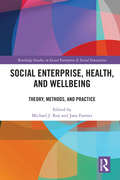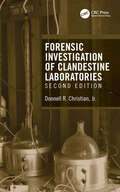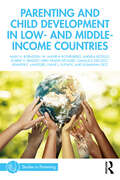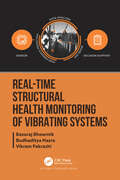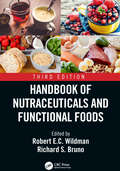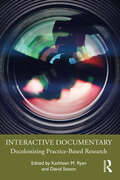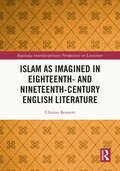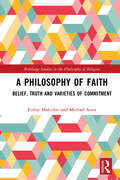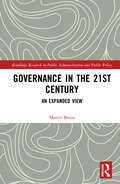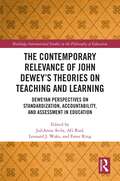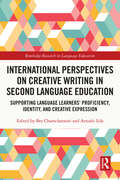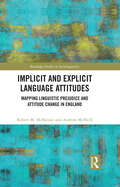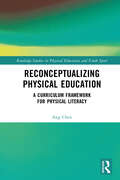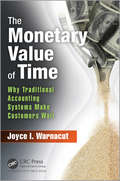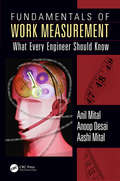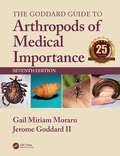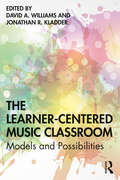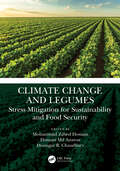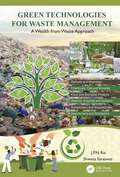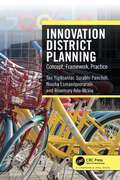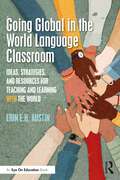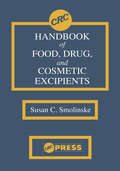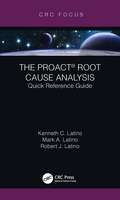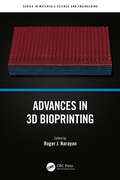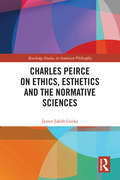- Table View
- List View
Social Enterprise, Health, and Wellbeing: Theory, Methods, and Practice (Routledge Studies in Social Enterprise & Social Innovation)
by Michael Roy Jane FarmerIn recent decades, governments have promoted social enterprise as a means to address welfare and tackle disadvantage. Early academic work on social enterprises reflected this development and engaged with their ability to deliver and create jobs, work towards remedial environmental goals, and address a range of societal challenges. More recently, researchers have started to investigate the broader potential of social enterprise for the wellbeing of people and the planet.In this context, this book aims to answer the question: In what ways can social enterprises improve the health and wellbeing of individuals and communities? The chapters in this edited collection take different perspectives on assessing how social enterprises address disadvantage and deliver health and wellbeing impacts. Drawing on evidence from international research studies, Social Enterprise, Health, and Wellbeing: Theory, Methods, and Practice presents the ‘first wave’ of innovative research on this topic and provides a platform of evidence to inspire the next generation of scholarly and policy interest. Drawing on the cutting edge of interdisciplinary research in the field, this book will be of interest to researchers, academics, policymakers, and students in the fields of entrepreneurship, public and social policy, community development, public health, human geography, and urban planning.
Forensic Investigation of Clandestine Laboratories
by Donnell R. Christian, Jr.Forensic Investigation of Clandestine Laboratories, Second Edition is fully updated to address all aspects of the forensic investigation of clandestine laboratories. While, the first edition focused on the domestic clandestine manufacture of contraband substances, this edition expands the scope to more fully address the clandestine manufacture of explosives that have become a threat that is global in nature. In clandestine laboratory operations, equipment is often simple, household chemical products are utilized, and the education of the operators basic. In fact, most of the time these elements individually are perfectly legal to sell and possess. However, the combination of all these elements is what becomes the scene of illicit activity and a criminal operation. In response to the increase in use of homemade explosive mixtures by terrorists, both domestically and internationally, the section clandestine manufacture of explosives is greatly enhanced. Topics are presented in a manner which, while detailed, will not compromise the tactics, techniques, or procedures utilized by law enforcement and military personnel in their ability to combat the clandestine manufacture of contraband substances and the battle against domestic and international terrorism.Key features: • Examines tell-tale signs to look for in recognizing a clandestine lab• Outlines how to safely process the site of a clandestine lab• Details how to analyze collected evidence in the examination laboratory • Provides guidelines as to what to derive from the physical evidence• Offers specific tactics to effectively present the opinions associated with evidence that has been collected during the investigation in a written report, military style briefing or to a jury in a legal proceeding.Forensic Investigation of Clandestine Laboratories, Second Edition guides the reader through the process of recognizing these illegal manufacturing operations. Then it examines the methods as to how to compile the volume of associated evidence into a package that can be presented in a court of law, or to military commanders for decisive action. It is an invaluable resource, that will prove useful to chemistry lab technicians, forensic investigators, fire and first responder professionals, military personnel, police investigative agencies and narcotics units, and lawyer trying cases involving clandestine labs.
Parenting and Child Development in Low- and Middle-Income Countries (Studies in Parenting Series)
by Marc H. Bornstein W. Andrew Rothenberg Andrea Bizzego Robert H. Bradley Kirby Deater-Deckard Gianluca Esposito Jennifer E. Lansford Diane L. Putnick Susannah ZietzThis compelling volume advances the understanding of what parenting and related sociodemographic, demographic, and environmental variables look like and how they are associated with child development in low- and middle-income countries around the world.Specifically, expert authors document how child growth, caregiving practices, discipline and violence, and children’s physical home environments, along with child and primary caregiver sociodemographic characteristics and household and national development demographic characteristics, are associated with central domains of early childhood development across a substantial fraction of the majority world using contemporary 21st-century data from the UNICEF Multiple Indicator Cluster Surveys and the UNICEF Early Childhood Development Index. The lives of nearly 160,000 girls and boys aged 3 to 5 years in nationally representative samples from 51 low- and middle-income countries are sampled to address 7 principal questions about children, caregiving, and contexts. Parenting and Child Development in Low- and Middle-Income Countries takes an authentically international approach to parenting, the environment, and child development in cultural contexts that more fully characterize the world’s diversity.Parenting and Child Development in Low- and Middle-Income Countries is essential reading for researchers and students of parenting, psychology, human development, family studies, sociology, and cultural studies, as well as governmental and non-governmental professionals working with families in low- and middle-income countries.
Real-Time Structural Health Monitoring of Vibrating Systems
by Basuraj Bhowmik Budhaditya Hazra Vikram PakrashiTargeted at researchers and practitioners in the field of science and engineering, the book provides an introduction to real time structural health monitoring. Most work to date is based on algorithms that require windowing of the accumulated data, this work presents a coherent transition from the traditional batch mode practice to a recently developed array of recursive approaches. The book mainly focuses on the theoretical development and engineering applications of algorithms that are based on first order perturbation (FOP) techniques. The development of real time algorithms aimed at identifying the structural systems and the inflicted damage, online, through theoretical approaches paves the way for an in-depth understanding of the discussed topics. It then continues to demonstrate the solution to a class of inverse dynamic problems through numerically simulated systems. Extensive theoretical derivations supported by mathematical formulations, pivoted around the simple concepts of eigenspace updates, forms the key cornerstone of the book. The output response streaming in real time from multi degree of freedom systems provide key information about the system’s health that is subsequently utilized to identify the modal parameters and the damage, in real time. Damage indicators connotative of the nature, instant and location of damage, identified in a single framework are developed in the light of real time damage case studies. Backed by a comprehensive assortment of experimental test-beds, this book includes demonstrations to emulate real life damage scenarios under controlled laboratory conditions. Applicability of the proposed recursive methods towards practical problems demonstrate their robustness as viable candidates for real time structural health monitoring.
Handbook of Nutraceuticals and Functional Foods
by Robert E.C. Wildman and Richard S. BrunoThe field of functional foods along with their bioactive food components has grown tremendously over the past decades. Often guided by hypothesis-generating epidemiological observations, discoveries from basic science studies and controlled trials in humans have provided critical evidence to help establish an optimal diet that alleviates chronic disease risk. These advances have also driven efforts by the food and nutraceutical industries to establish and market health claims, formulate extra-value foods, and even generate new health foods for human benefit.Handbook of Nutraceuticals and Functional Foods, Third Edition, compiles the data from experts in the field that potentiates the already established credibility of the earlier editions. In its three-section format, it provides an authoritative summary of the prophylactic and/or medicinal benefits of natural foods and their constituents that are linked to favorable health outcomes. Beginning with an overview of the field and associated regulations, each chapter describes the chemical properties, bioactivities, dietary sources, and evidence of these health-promoting dietary constituents.Features:• Summarizes plant- and animal-based functional foods and their bioactive components• New chapters on cannabidiol and scientific, legal, and regulatory considerations; green tea and nutraceutical applications; and herbal nutraceuticals and insulin resistance• Includes information on functional food beverages including coffee, green tea, and dairy milk• Discusses antioxidant and anti-inflammatory activities of vitamin E, anthocyanins and other (poly)phenolic compounds, and carotenoids• Provides an update on the health benefits and requirements of protein and performance and therapeutic application and safety of creatine.
Interactive Documentary: Decolonizing Practice-Based Research
by Kathleen M. Ryan David Staton Tammy Rae MatthewsInteractive documentary is still an emerging field that eludes concise definitions or boundaries. Grounded in practice-based research, this collection seeks to expand the sometimes exclusionary field, giving voice to scholars and practitioners working outside the margins. Editors Kathleen M. Ryan and David Staton have curated a collection of chapters written by a global cohort of scholars to explore the ways that interactive documentary as a field of study reveals an even broader reach and definition of humanistic inquiry itself. The contributors included here highlight how emerging digital technologies, collaborative approaches to storytelling, and conceptualizations of practice as research facilitate a deeper engagement with the humanistic inquiry at the center of documentary storytelling, while at the same time providing agency and voice to groups typically excluded from positions of authority within documentary and practice-based research, as a whole. This collection represents a key contribution to the important, and vocal, debates within the field about how to avoid replicating colonial practices and privileging.This is an important book for practice-based researchers as well as advanced-level media and communication students studying documentary media practices, interactive storytelling, immersive media technologies, and digital methodologies.
Islam as Imagined in Eighteenth and Nineteenth Century English Literature (Routledge Interdisciplinary Perspectives on Literature)
by Clinton BennettSince medieval times, English literature has often demonized Muslims. The term ‘Islamophobia’ is recent, but the phenomenon is old. This survey of literature focusing on the modern period up to 1914 identifies negative ideas about Islam in novels and plays. Some works are iconic, some more obscure. However, the book highlights writers who challenged stereotypes and tended to see Muslims as equally capable of virtue and vice as Christians and others. The book deals with the role of the imagination in depicting others and how this serves authors’ agendas. The conclusion brings the book’s thesis into dialogue with the debate in the USA today between supporters of multiculturalism and its critics. Anyone interested in how stereotypes are formed, perpetuated and can be challenged will profit from this book. It is aimed at a non-specialist readership.
A Philosophy of Faith: Belief, Truth and Varieties of Commitment (Routledge Studies in the Philosophy of Religion)
by Finlay Malcolm Michael ScottFaith occupies an important place in human lives. It can be directed towards God, friends, political systems and sports teams, and is said to help people through crises and to motivate people to achieve life goals. But what is faith? Philosophers and theologians have, for centuries, been concerned with questions about the rationality of faith, but more recently, have focussed on what kind of psychological attitude faith is. The authors of this book bring together, for the first time, the different elements of this recent debate, staking out the different positions and arguments, and defending a novel ‘true grit’ theory of faith, from which the rationality and language of faith are addressed from a fresh perspective. The book engages with a range of questions about the nature of faith, including: Does faith require belief? Is faith motivational? What is the relationship between faith, trust and hope? Do expressions of faith aim at the truth? And, in what sense is faith resilient? The authors defend a distinctive conception of faith involving resistance to psychological, practical and epistemic challenges, from which a novel account of the psychology and epistemology of faith is developed. The treatment of the topic draws extensively on the philosophy of mind, language and religion, and provides a map of this exciting field of study for newcomers to the philosophy of faith. A Philosophy of Faith will appeal to researchers and advanced students in philosophy of religion, philosophy of mind, philosophy of language and epistemology who are interested in the topic of faith.
Governance in the 21st Century: An Expanded View (Routledge Research in Public Administration and Public Policy)
by Morris BosinIn Governance in the 21st Century, Morris Bosin offers an integrated approach in addressing real world governance challenges.Divided into four broad sections, Bosin begins in Part 1 by introducing the nature of governance, its use in the public and private sector, and at different levels in our society. Part 2covers traditional and emerging approaches to governance and reviews the various epistemological roots that frame our understanding of governance approaches. Part 3 includes a detailed discussion of the three components of his proposed approach to an expanded view of governance – requisite variety, complexity, and reflexivity. Part 4 illustrates the application of this approach through the use of case studies targeted at selected Federal agencies as well as at specific societal issues including the FDA's Drug Review Program, Bureau of Indian Education Program, U.S. Customs and Border Protection, COVID 19, and Police Department Strategies.Crossing traditional disciplinary lines, Bosin’s integrated approach will guide the academic community as well as practitioners toward a more holistic view of governance and offer generic solutions that can be adapted to any number of issues that portend transformational change for society.
The Contemporary Relevance of John Dewey’s Theories on Teaching and Learning: Deweyan Perspectives on Standardization, Accountability, and Assessment in Education (Routledge International Studies in the Philosophy of Education)
by JuliAnna ÁvilaThrough expert analysis, this text proves that John Dewey’s views on efficiency in education are as relevant as ever. By exploring Deweyan theories of teaching and learning, the volume illustrates how they can aid educators in navigating the theoretical and practical implications of accountability, standardization, and assessment. The Contemporary Relevance of John Dewey’s Theories on Teaching and Learning deconstructs issues regarding accountability mechanisms, uniform assessment systems, and standardization processes through a Deweyan lens. Connecting the zeitgeist of the era from which Dewey’s ideas emerged and current global political, social, and economic contexts, the book emphasizes the importance of resilient systems in reconciliating the tension between standardized assessments and individual student development. Contributors provide insights from a range of settings across Pre-K, primary, secondary, and higher education and address topics including teacher agency, voice, leadership, and democracy.The volume will be of interest to scholars, researchers, and academics with an interest in philosophy of education, education policy and the impact of neoliberal agendas, as well as teaching and learning more broadly.
International Perspectives on Creative Writing in Second Language Education: Supporting Language Learners’ Proficiency, Identity, and Creative Expression (Routledge Research in Language Education)
by Bee Chamcharatsri Atsushi IidaThis volume explores the instructional use of creative writing in secondary and post-secondary contexts to enhance students’ language proficiency and expression in English as a second or foreign language (ESL/EFL).Offering a diverse range of perspectives from scholars and practitioners involved in English language teaching (ELT) globally, International Perspectives on Creative Writing in Second Language Education tackles foundational questions around why fiction and creative writing have been traditionally omitted from ESL and EFL curricula. By drawing on empirical research and first-hand experience, contributors showcase a range of creative genres including autobiography, scriptwriting, poetry, and e-Portfolios, and provide new insight into the benefits of second language creative writing for learners’ language proficiency, emotional expression, and identity development. The volume makes a unique contribution to the field of second language writing by highlighting the breadth of second language users throughout the world, and foregrounding links between identity, learning, and ESL/EFL writing. This insightful volume will be of particular interest to postgraduate students, researchers, and academics in the fields of ESL/EFL learning, composition studies, and second language acquisition (SLA). Those with a focus on the use of creative writing in classrooms more broadly, will also find the book of interest.
Implicit and Explicit Language Attitudes: Mapping Linguistic Prejudice and Attitude Change in England (Routledge Studies in Sociolinguistics)
by Robert M. McKenzie Andrew McNeillThis timely volume constitutes the first book-length account of implicit as well as explicit language attitudes. It details the findings of a large-scale study, incorporating cutting-edge implicit and self-report instruments adapted from social psychology, investigating the evaluations of over 300 English nationals of the status and social attractiveness of Northern English and Southern English speech in England.The book is unique in its examination of implicit-explicit attitude divergence, across a range of social factors, to identify the direction of language attitude change in progress and the particular social groups leading attitude change. The volume provides a comprehensive understanding of language-based prejudice in England and the study paves the way for researchers to employ newly developed implicit and explicit measures to investigate language attitudes and language attitude change in a range of contexts.This book is invaluable for researchers in sociolinguistics and applied linguists interested in theoretical and methodological aspects of linguistic prejudice and language variation and change. It is also essential reading for social psychologists with an interest in attitudes, attitude change and prejudice.
Reconceptualizing Physical Education: A Curriculum Framework for Physical Literacy (Routledge Studies in Physical Education and Youth Sport)
by Ang ChenPhysical education curricula evolved to emphasize physical training, personal hygiene, character development, fitness development, sports competency, and health. These emphases led to different ways to conceptualize the curricula for primary and secondary schools. This book raises a need to re-conceptualize the physical education curriculum and proposes a life-scan perspective for physical education curriculum conceptualization. Reconceptualizing Physical Education proposes a conceptual framework to focus on the life journey of physical activity, which is guided by the monist perspective and a lifelong approach to physical literacy. Section I of the book lays out important theoretical articulation for a two-dimensional framework with the goal of educating the learner to take a lifelong perspective to personal health and physically active lifestyles. Section II presents curriculum frameworks designed for primary schools and secondary schools. In each framework chapter, the details of content and learning tasks are discussed in terms of the two-dimensional functions. Each framework may be used directly for curriculum development. The book is intended for curriculum scholars and researchers in physical education, graduate students in health and physical education curriculum studies, and teachers in physical education and health education. It may also be of interest of researchers and graduate students in kinesiology fields and public health.
The Monetary Value of Time: Why Traditional Accounting Systems Make Customers Wait
by Joyce I. WarnacutAlthough there are numerous books on alternative accounting methods, such as Lean accounting, none focus on the impact of time and how accounting practices can be modified to acknowledge the power of time. This book addresses this need.The Monetary Value of Time: Why Traditional Accounting Systems Make Customers Wait presents a framework for assessing the value of time in terms of organizational strategy and competitive advantage. The framework presented will enable organizations to develop consistent measures and ensure that their cost accounting system isn’t motivating behaviors that add to lead time and make customers wait.The framework outlined in this book is relevant to the managerial and cost accounting practices in today’s manufacturing environment, which is increasingly moving away from mass production to custom manufacturing. The framework is supported by high-level metrics, which are reinforced by operational metrics. This is supported by accounting data that recognize the value of time. Pricing models that incorporate the concept of time are presented. The book provides many examples of how the use of standard costing and traditional accounting practices in a high-mix/low-volume production environment can produce contradictory or even inaccurate results that form the basis for poor decisions that may actually move your organization farther from its objectives.The book arms readers with options for overcoming traditional barriers by applying direct costs at an item level, while applying overheads at a macro or value stream level. For example, while GAAP requires overhead application for inventory valuation, a common misconception is that overhead must be applied at an item level. In fact, overhead can be absorbed by one journal entry. Demonstrating the linkages between time-based accounting data and meaningful business metrics that drive bottom line results, the book presents methods and metrics that have been successfully applied by the author in manufacturing environments.
Fundamentals of Work Measurement: What Every Engineer Should Know
by Anil Mital Anoop Desai Aashi MitalThis book will provide a quick reference on Work Measurement. While the nature of the work may differ, measuring work is fundamental to any industrial or service activity. It’s needed to determine such things as the amount a person should be paid, how much time should it take to perform an activity, what is an acceptable days’ work, or how any two or more methods or designs compare. This book provides non-industrial engineers with the why and the how work is measured in order to perform their jobs.
The Goddard Guide to Arthropods of Medical Importance
by Gail Miriam Moraru Jerome Goddard IICovering all major arthropods of medical importance worldwide, this award-winning resource has established itself as a standard reference for almost 25 years. With the globilization of commerce and the world becoming more intimately connected through the everyday ease of travel, unknown arthropod species are being increasingly encountered. This means access to up-to-date, authoritative information in medical entomology has never been more important. Now in its seventh edition, this book maintains its well-acclaimed status as the ultimate easy-to-use guide to identify disease-carrying arthropods, the common signs and symptoms of vector-borne diseases, and the current recommended procedures for treatment. Includes an in-depth chapter with diagnostic aids to help physicians to recognize and accurately diagnose arthropod-related diseases and conditions more easilyUpdates all chapters with the latest medical and scientific findings, including Zika virus, red meat allergy, new viruses found in ticks, and vaccine development for malaria and dengue feverPresents a greater medical parasitology emphasis throughout Offers electronic downloads containing additional photographs of arthropod-caused diseases and lesions, as well as instructional videos with pest identification aids, basic entomology, and insect and pest ecology.Illustrated throughout with detailed color images to aid identification, The Goddard Guide to Arthropods of Medical Importance, Seventh Edition will remain an essential guide for physicians, public health officials, and pest control professionals.
The Learner-Centered Music Classroom: Models and Possibilities
by David A. Williams Jonathan R. KladderThe Learner-Centered Music Classroom: Models and Possibilities is a resource for practicing music teachers, providing them with practical ideas and lesson plans for implementing learner-centered pedagogical concepts into their music classrooms. The purpose of this book is to propose a variety of learner-centered models for music teaching and learning through the use of a variety of autoethnographic viewpoints. Nine contributors provide working and concrete examples of learner-centered models from their classrooms. Offering lesson plan ideas in each of these areas, the contributors provide practical approaches for implementation of learner-centered approaches in music instruction across a variety of landscapes.Learner-centered teaching provides an approach to music education that encourages social, interactive, culturally responsive, creative, peer-based, open-formed, facilitated and democratic learning. Chapter 1 defines the what, why, and perceived benefits of learner-centered approaches in music teaching and learning contexts Chapters 2-10 will include example lesson plans, rubrics, etc. as models for teachers. The contributors to this book suggest that learner-centered approaches, when embedded into the culture and curricular framework of a music classroom, offer exciting approaches for teaching music in ways that are culturally and educationally appropriate in contemporary education.
Climate Change and Legumes: Stress Mitigation for Sustainability and Food Security
by Mohammad Zabed Hossain Hossain Anawar Doongar R. ChaudharyGlobal climate change has created unprecedented challenges for human civilization due to its widespread adverse consequences, including a reduction in crop yield and threatening food security across the globe. Among the crop plants, legumes have great potential for ameliorating global warming since they can reduce carbon emissions by lowering reliance on the application of chemical fertilizers, by increasing nitrification and carbon sequestration in soil, and by providing protein-rich diets to both humans and livestock. This book identifies the extent of climate-induced stresses on legume plants and focuses on achieving food security through sustainable agricultural practices.This book compiles recent research findings and reviews on climate-related problems, the potential of legumes in ameliorating the impacts of climate change, as well as better management of agricultural land and practices for achieving environmental sustainability and food security.This book will serve as guidelines for scientists, agricultural practitioners, and policymakers working to achieve food security and better management of climate-induced stresses in agricultural interventions. It will also be useful as a reference book for researchers and students of both graduate and postgraduate levels. Furthermore, this book will provide enhanced knowledge about the mechanisms of yield and stress tolerance of legumes as well as developing climate-smart crops and improving cropping systems for a sustainable environment and food security. Features of the book Reviews trends of global climate change and its consequences for food security across the continents Identifies the challenges and scopes of cultivating legumes in achieving food security in the context of global climate change Focuses on the improvements of legume production through conservation approaches in agricultural practices and modern techniques, including omics-based breeding, biotechnology, genetic engineering, and rhizobium technology Discusses the sustainable amelioration options for soils affected by climate-induced stresses Cites examples of applications of rhizobium technologies in reducing greenhouse gas emission Describes pathways associated with yield, resistance, and tolerance of legumes to climate-induced stresses
Green Technologies for Waste Management: A Wealth from Waste Approach
by J.P.N. Rai Shweta SaraswatProper waste disposal is still a serious concern worldwide. This book addresses various types of wastes such as industrial, agricultural, and municipal solid and liquid wastes, their generation, and the status of waste management in developed and developing countries. It discusses advanced green technologies used in harnessing energy and bioproducts from wastes such as electricity, biofuel, biopolymers, fertilizers, and chemicals without damaging the quality of the environment but rather creating a source that is an added value to the environment. Through many applications and case studies, this comprehensive book helps readers build a state-of-the-art knowledge on waste utilization and energy generation.FEATURES Provides a comprehensive, state-of-the-art coverage of waste management practices, their challenges, and solutions from a global perspective Discusses conceptual principles and practices of various green technologies that can be used to generate valuable products from waste and improve environmental quality Includes case studies from the United States and Japan, providing detailed explanations of advanced bioremediation technologies Takes a holistic approach to waste management and bioproducts recovery Offers an easy-to-understand and target-oriented approach that helps both students and professionals advance their knowledge in creating wealth from waste Written for undergraduate and graduate students taking courses in environmental biotechnology, environmental microbiology, non-conventional energy sources, waste treatment technologies, environmental waste utilization, energy, and environment taught in universities and colleges. The book can also be used by professionals and researchers at different levels in related fields.
Innovation District Planning: Concept, Framework, Practice
by Tan Yigitcanlar Surabhi Pancholi Niusha Esmaeilpoorarabi Rosemary Adu-McVieThis book aims to fill the knowledge gap on how to plan, develop and manage innovation districts that are competitive in terms of both productivity and quality of living, justifying the massive investment put into place and at the same time doing both in a delicate and harmonious way.There is a need for smart urban land use that is wired with both hard infrastructures (e.g., telecommunication and transport) and soft infrastructures (e.g., diversity and tolerance). The reader learns this knowledge through conceptual expansions for key insights, frameworks for potential and performance assessment and best practices for global innovation districts. The authors begin innovation district planning with the role and effectiveness of planning a branding in the development of innovation districts. The next key topic of place making is recognised as a key strategy for supporting knowledge generation and innovation activities in the contemporary innovation districts. Another important topic is place quality where the reader learns to identify and classify indicators of place quality by studying global innovation districts best practices. The reader also expands their understanding on the classification of innovation districts based on their key characteristics through a methodological approach. The book concludes with district smartness studied through the socio-cultural role played by anchor universities in facilitating place making in innovation districts. Smart campuses, enabled by digital transformation opportunities in higher education, are seen as a miniature replica of smart cities and serve as living labs for smart technology.The book serves as a repository for scholars, researchers, postgraduate and undergraduate students as it communicates the complex innovation district phenomenon in an easy-to-digest form by providing both the big picture view and specifics of each component of that view.
Going Global in the World Language Classroom: Ideas, Strategies, and Resources for Teaching and Learning With the World
by Erin AustinWith this practical resource, you’ll learn how to promote global readiness and build international connections in the world language classroom. Master educator Erin E.H. Austin shares original strategies to facilitate productive language learning and demonstrates how to foster a rigorous, inclusive, and enriching environment. Designed to improve student motivation and engagement, the book is a shift from teaching about the world to teaching with the world. You’ll come away with plenty of inspiring and effective ways to not only invite the world into the classroom but also bring the classroom to the world and, in so doing, support an inviting classroom environment.The book abounds with low-cost, ready-to-implement tools, activities, and lesson ideas. The approaches in this book include coordinating international and world language events at school, using online resources to connect students to new languages and cultures, and broadening student horizons through books and podcasts. Austin also offers ways that further develop students’ global education through travel and study abroad opportunities. With this book, your students will become culturally literate, motivated language learners who will be ready to enter the global community and continue to learn from and with the world.
CRC Handbook of Food, Drug, and Cosmetic Excipients
by Susan C. SmolinskeCRC Handbook of Food, Drug, and Cosmetic Excipients provides a comprehensive summary of toxicological issues regarding inactive ingredients in pharmaceutical products, cosmetic products, and food additives. Background information on regulations and labeling requirements for each type of product is provided, and 77 articles critically review human and animal data pertinent to a variety of agents and makes judgments regarding the clinical relevance. The book also identifies at-risk populations, such as neonates, patients with renal failure, and atopic patients. Inactive common pharmaceutical agents and/or foods containing certain ingredients are listed to help physicians counsel hypersensitive patients who must avoid products containing these excipients.
The PROACT® Root Cause Analysis: Quick Reference Guide (Reliability, Maintenance, and Safety Engineering)
by Kenneth C. Latino Mark A. Latino Robert J. LatinoRoot Cause Analysis, or RCA, "What is it?" Everyone uses the term, but everyone does it differently. How can we have any uniformity in our approach, much less accurately compare our results, if we’re applying different definitions? At a high level, we will explain the difference between RCA and Shallow Cause Analysis, because that is the difference between allowing a failure to recur or dramatically reducing the risk of recurrence.In this book, we will get down to basics about RCA, the fundamentals of blocking and tackling, and explain the common steps of any investigative occupation. Common investigation steps include: Preserving evidence (data)/not allowing hearsay to fly as fact Organizing an appropriate team/minimizing potential bias Analyzing the events/reconstructing the incident based on actual evidence Communicating findings and recommendations/ensuring effective recommendations are actually developed and implemented Tracking bottom-line results/ensuring that identified, meaningful metrics were attained We explore, "Why don’t things always go as planned?" When our actual plans deviate from our intended plans, we usually experience some type of undesirable or unintended outcome. We analyze the anatomy of a failure (undesirable outcome) and provide a step-by-step guide to conducting a comprehensive RCA based on our 3+ decades of applying RCA as we have successfully practiced it in the field. This book is written as a how-to guide to effectively apply the PROACT® RCA methodology to any undesirable outcome, is directed at practitioners who have to do the real work, focuses on the core elements of any investigation, and provides a field-proven case as a model for effective application. This book is for anyone charged with having a thorough understanding of why something went wrong, such as those in EH&S, maintenance, reliability, quality, engineering, and operations to name just a few.
Advances in 3D Bioprinting (Series in Materials Science and Engineering)
by Roger J. Narayan"3D bioprinting" refers to processes in which an additive manufacturing approach is used to create devices for medical applications. This volume considers exciting applications for 3D bioprinting, including its use in manufacturing artificial tissues, surgical models, and orthopedic implants.The book includes chapters from leaders in the field on 3D bioprinting of tissues and organs, biomedical applications of digital light processing, biomedical applications of nozzle-free pyro-electrohydrodynamic jet printing of buffer-free bioinks, additive manufacturing of surgical models, dental crowns, and orthopedic implants, 3D bioprinting of dry electrodes, and 3D bioprinting for regenerative medicine and disease modeling of the ocular surface.This is an accessible reference for students and researchers on current 3D bioprinting technology, providing helpful information on the important applications of this technology. It will be a useful resource to students, researchers, and practitioners in the rapidly growing global 3D bioprinting community.
Charles Peirce on Ethics, Esthetics and the Normative Sciences (Routledge Studies in American Philosophy)
by James Jakób LiszkaThis book presents a comprehensive and systematic picture of Charles Peirce’s ethics and aesthetics, arguing that Peirce established a normative framework for the study of right conduct and good ends. It also connects Peirce’s normative thought to contemporary debates in ethical theory.Peirce sought to articulate the relation among logic as right thinking, ethics as good conduct and, in an unorthodox sense of aesthetics, the pursuit of ends that are fine and worthy. Each plays an important role in ethical life. Once aesthetics has determined what makes an end worthy and admirable, and ethics determines which are good and right to pursue, logical and scientific reasoning is employed to figure the most likely means to attain those ends. Ethics does the additional duty of ensuring that the means conform to ideals of conduct. In the process, Peirce develops an interesting theory of moral motivation, an account of moral reasoning, moral truth, and a picture of what constitutes a moral community.Charles Peirce on Ethics, Esthetics and the Normative Sciences will be of interest to scholars and students working on Peirce, American philosophy, and metaethics.
